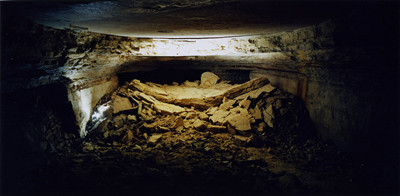Naoya Hatakeyama
30 Apr - 23 May 2008

© Naoya Hatakeyama
"Ciel Tombé" 2007
Lambda print, 49 x 100 cm
Courtesy of the artist and Taka Ishii Gallery
"Ciel Tombé" 2007
Lambda print, 49 x 100 cm
Courtesy of the artist and Taka Ishii Gallery
NAOYA HATAKEYAMA
"Ciel Tombé"
Taka Ishii Gallery is pleased to announce our fourth solo exhibition with Naoya Hatakeyama. For this exhibition the gallery will present, approximately 15 photographs from Hatakeyama's recent “Ciel Tombé” series, photographed in Paris, 2007.
In Europe, there are cities that quarried stone directly below an urban area to construct the city itself. Among such cities, Paris was exceptional for undergoing massive digging. Due to continuous digging from the Middle Ages to modern times, Paris's underground is full of holes to such an extent as to be comparable to Gruyére cheese. In fact, catacombs (underground cemeteries) photographed by Nadar in the nineteenth century and now famous as tourist spots were created using the portions of the old quarries.
Hatakeyama, who once wrote in his artist book “Lime Works” that “Mines and cities are like the negative and positive of a single photograph”, noticed that similar structures unfolded vertically in modern Paris and visited the remains of several underground quarries (mostly made of lime stone) with the cooperation of Inspection Générale des Carriéres.
“Ciel Tombé” is a term referring to a situation in which the ceilings of the subterranean quarry remains have tumbled down. (A direct translation is “fallen sky”.) As abandoning these sites would eventually cause harmful effects towards over-ground construction, through consolidation work was conducted by the Inspectorate during the twentieth century.
Yet some “Ciel Tombé’s were left abandoned in a former quarry called “la Brasserie”. Lying 17 meters underground of the Bois de Vincennes, on the eastern end of Paris, the over-ground has only forest land and no buildings. No one knows exactly when the “sky fell down”.
Ciel Tombé
Newton's apple stopped as it fell on the ground but this is not the end point of gravity.
The earth’s surface is merely a hand held out in the middle of a fall and gravity penetrates this, leading further down towards the center of the earth.
It is said that in the ancient times, there were people who worried that the sky they looked up to would fall some day. Though it is difficult for us living in an age of science to imagine the view of “the sky falling down”, if we consider this as meaning that “the sky” is a place above us resisting gravity, we can imagine the anxiety of ancient people. The blue sky above was probably not an “empty sky” but a “place” for them.
And the sky fell down. It penetrated vertically through cities, architecture and our bodies, falling underground. The sky has now become an ancient layer of earth permeating below the city we live.
Naoya Hatakeyama
"Ciel Tombé"
Taka Ishii Gallery is pleased to announce our fourth solo exhibition with Naoya Hatakeyama. For this exhibition the gallery will present, approximately 15 photographs from Hatakeyama's recent “Ciel Tombé” series, photographed in Paris, 2007.
In Europe, there are cities that quarried stone directly below an urban area to construct the city itself. Among such cities, Paris was exceptional for undergoing massive digging. Due to continuous digging from the Middle Ages to modern times, Paris's underground is full of holes to such an extent as to be comparable to Gruyére cheese. In fact, catacombs (underground cemeteries) photographed by Nadar in the nineteenth century and now famous as tourist spots were created using the portions of the old quarries.
Hatakeyama, who once wrote in his artist book “Lime Works” that “Mines and cities are like the negative and positive of a single photograph”, noticed that similar structures unfolded vertically in modern Paris and visited the remains of several underground quarries (mostly made of lime stone) with the cooperation of Inspection Générale des Carriéres.
“Ciel Tombé” is a term referring to a situation in which the ceilings of the subterranean quarry remains have tumbled down. (A direct translation is “fallen sky”.) As abandoning these sites would eventually cause harmful effects towards over-ground construction, through consolidation work was conducted by the Inspectorate during the twentieth century.
Yet some “Ciel Tombé’s were left abandoned in a former quarry called “la Brasserie”. Lying 17 meters underground of the Bois de Vincennes, on the eastern end of Paris, the over-ground has only forest land and no buildings. No one knows exactly when the “sky fell down”.
Ciel Tombé
Newton's apple stopped as it fell on the ground but this is not the end point of gravity.
The earth’s surface is merely a hand held out in the middle of a fall and gravity penetrates this, leading further down towards the center of the earth.
It is said that in the ancient times, there were people who worried that the sky they looked up to would fall some day. Though it is difficult for us living in an age of science to imagine the view of “the sky falling down”, if we consider this as meaning that “the sky” is a place above us resisting gravity, we can imagine the anxiety of ancient people. The blue sky above was probably not an “empty sky” but a “place” for them.
And the sky fell down. It penetrated vertically through cities, architecture and our bodies, falling underground. The sky has now become an ancient layer of earth permeating below the city we live.
Naoya Hatakeyama
